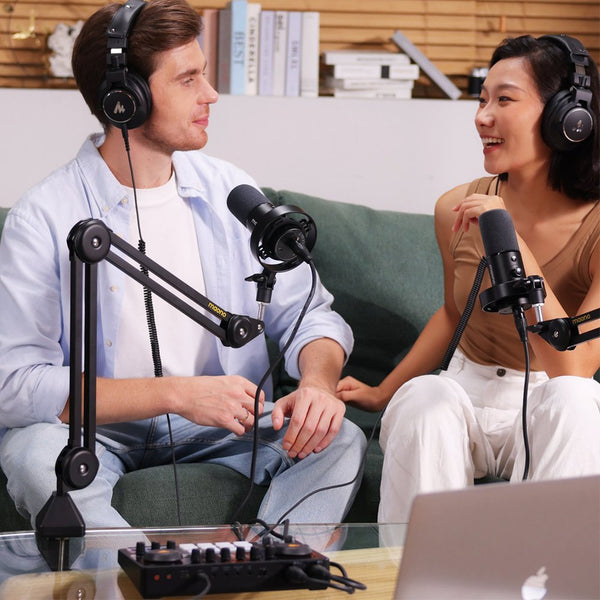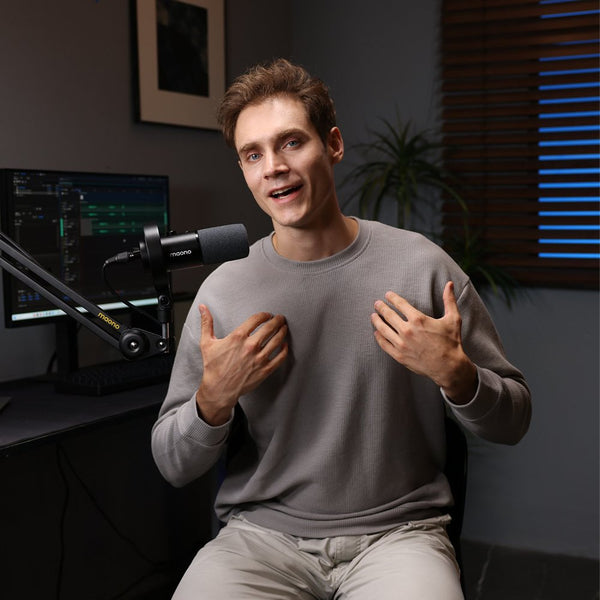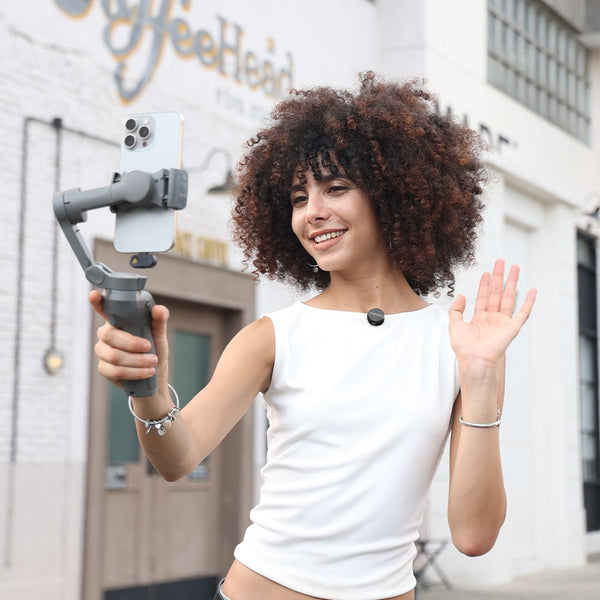Do you sometimes get confused between a vlog and a podcast? Both are effective mediums for sharing information. Let's explore the difference between the two.
In the fast-evolving world of content creation, both vlogs and podcasts have established themselves as powerful platforms for storytelling, education, and entertainment. But as a new creator in 2025, you may wonder: What’s the actual difference between a vlog and a podcast? And more importantly, how do you choose the right podcast microphone or vlogging mic to match your content goals?

Vlog vs Podcast: What's the Real Difference?
A vlog (video blog) is a visual-first format that focuses on capturing lifestyle, tutorials, or entertainment using both video and audio. A podcast, on the other hand, is primarily audio-based—built for listening, whether on a morning walk or during a long commute. While podcasts can include video elements, their structure is fundamentally audio-centric.
Can a Vlog Also Be Considered a Podcast?
Technically, yes—if it’s audio-focused and distributed via podcasting platforms like Spotify, Apple Podcasts, or Google Podcasts. A vlog uploaded to YouTube that features only spoken audio without visual storytelling elements could qualify as a video podcast, but it wouldn’t be a traditional vlog. It’s all about intent and distribution.
The Importance of Mic Versatility
Whether you choose vlogging or podcasting, audio quality is critical. Viewers can forgive slightly shaky video, but poor audio is a deal-breaker. That’s why choosing a versatile, high-quality podcast mic or streaming microphone that matches your content format is essential in 2025, where audiences expect clarity and professionalism.
Should You Start a Vlog or a Podcast in 2025?
That depends on your personality, goals, and audience. If you're comfortable on camera and thrive in visual storytelling, vlogging might be for you. If you're more focused on discussions, interviews, or in-depth commentary, a podcast is likely the better choice.
Also consider production complexity: Vlogging requires good lighting, video editing skills, and camera presence. Podcasting is typically more accessible—requiring only a quality podcast microphone, a quiet space, and editing software.
Audience Engagement: Vlog vs Podcast
Vlogs often gain more immediate interaction—likes, shares, and comments—due to the visual appeal. Podcasts, on the other hand, foster deep engagement. Listeners often tune in for longer, forming a strong connection with the host’s voice and message.
Production Differences Between the Two
-
Vlogs need a camera, lighting, editing software (like Adobe Premiere), and clear audio.
-
Podcasts need excellent sound (a good podcast mic), simple editing (Audacity, GarageBand), and a hosting platform.
While vlogs emphasize aesthetics, podcasts emphasize soundscapes and storytelling.
What is a Video Podcast—and How Is It Different from Vlogging?
A video podcast merges the podcast’s structure (interviews, monologues, discussions) with a video component, often shot in a studio setting. It’s not as cinematic as a vlog and lacks the day-in-the-life or travel-based feel of traditional vlogging. Think of video podcasts as talk shows, whereas vlogs are more like personal documentaries.
Microphone Usage FAQs:
Do You Need a Special Microphone for Vlogging or Podcasting?
Yes. Smartphone mics or camera mics don’t cut it for serious creators. Vlogs and podcasts benefit immensely from external mics—either shotgun mics for cameras or USB/XLR mics for desktops. A good microphone for streaming or podcasting ensures clean, clear, and professional audio.
What Type of Microphone Is Best for a Podcast?
Two excellent podcast microphones for 2025 are:
-
Hybrid Connectivity: USB and XLR support gives flexibility.
-
Built-in RGB lighting: A bonus for streamers and video podcasters.
-
Dynamic Mic with Cardioid Pattern: Excellent background noise rejection.
-
Headphone Jack: Real-time monitoring helps fine-tune your delivery.
-
Compact & Durable Design: Great for minimalist setups or travel.
-
XLR Output Only: Ideal for users with an audio interface.
-
Dynamic Mic with Excellent Sound Isolation: Crystal-clear vocal pickup, even in noisy environments.
Both models offer professional sound quality at a competitive price, making them ideal for podcasters looking to level up with a reliable cardioid microphone.
Can I Use My Vlogging Mic for Podcasting Too?
Possibly—but with caveats. Vlogging mics, especially wireless lavaliers or on-camera shotguns, are designed for mobile, directional use. They work well outdoors or on the move. However, they usually lack the depth and warmth that studio podcast mics—like a dynamic cardioid mic—offer. If you're serious about podcasting, it’s best to invest in a dedicated streaming microphone.
Benefits of Using a Podcasting Mic Over a Phone Mic
-
Noise Reduction
Better background rejection in uncontrolled environments with a cardioid mic.
-
Improved Clarity
Your voice sounds fuller and more natural.
-
Professionalism
Increases listener trust and retention.
-
Editing Flexibility
Higher-quality recordings are easier to clean and enhance in post-production.
What Features Should I Look for in a Vlog Mic?
When choosing a mic for vlogging, consider:
-
Portability
Lightweight and easy to mount.
-
Directional Pickup
Cardioid or supercardioid patterns work best.
-
Wireless Options
For movement-intensive content (e.g., fitness, travel).
-
Compatibility
Make sure it works with your camera or smartphone.
Popular vlog mic options include wireless lavaliers (for mobility) and shotgun mics (for camera-mounted clarity).
How Important Is Background Noise Rejection for Podcasts?
Very important. Podcasts are often consumed through headphones, which amplify imperfections. Using a dynamic cardioid mic—like the Maono PD200X—can significantly reduce keyboard clicks, AC hums, or ambient street noise.
Do I Need a Boom Arm or Stand for Vlogging or Podcasting?
-
For podcasting: A boom arm enhances flexibility and keeps your podcast microphone steady at the right height.
-
For vlogging: A handheld grip, gimbal, or tripod is more appropriate.
Investing in a good mic arm or mount makes a noticeable difference in audio consistency and comfort during long recordings.
How Do You Improve Audio Quality in a Vlog Without Spending Much?
-
Use a clip-on lavalier mic for under $50.
-
Record in quiet locations or use soft furnishings to reduce echo.
-
Edit your audio with free software like Audacity to remove background hiss.
-
Monitor audio while recording to catch issues early.
Small upgrades in gear and setup go a long way in boosting your vlog's professionalism.
Should I Invest in a Mic First or a Camera When Starting a Vlog?
Start with the mic. Viewers tolerate average video but abandon videos with poor sound. A $50–$100 streaming microphone can dramatically improve your content—even if you’re using a smartphone camera.
Can Better Sound Increase Podcast Subscriber Numbers?
Absolutely. Podcasts live or die by their audio. Clean, consistent sound shows listeners that you care about quality and makes your content easier to consume. Good sound also leads to:
-
Higher retention rates
-
More shares and recommendations
-
Better listener reviews
Quality sound builds trust, and trust builds a loyal audience.
Conclusion
As a creator in 2025, deciding between a vlog and a podcast comes down to your style, goals, and the way you want to connect with your audience. Both formats are powerful—but regardless of your choice, audio quality is non-negotiable.
Whether you're filming lifestyle content on the go or recording thoughtful podcast interviews at home, investing in the right podcast microphone will elevate your content and help you stand out. Models like the Maono PD200X and PD100X offer professional-grade sound without the complexity, making them ideal for both beginners and pros.
In the world of digital content, your voice is your brand. Make sure it’s heard—loud, clear, and unforgettable—with the right cardioid microphone, podcast mic, or microphone for streaming.




